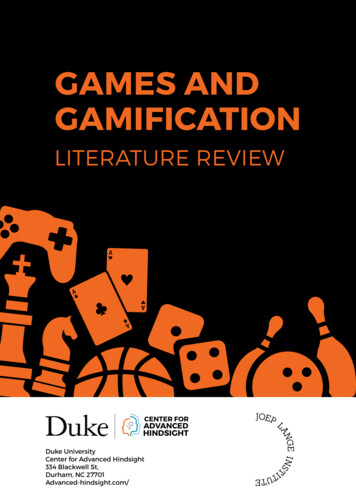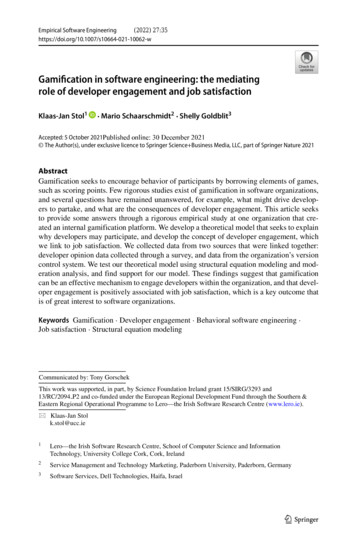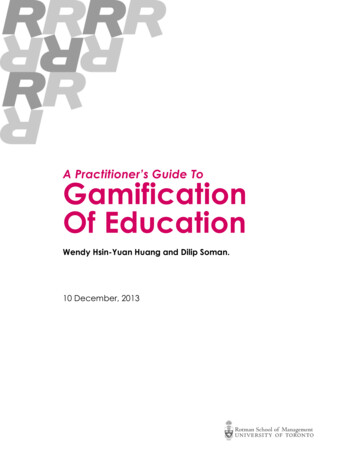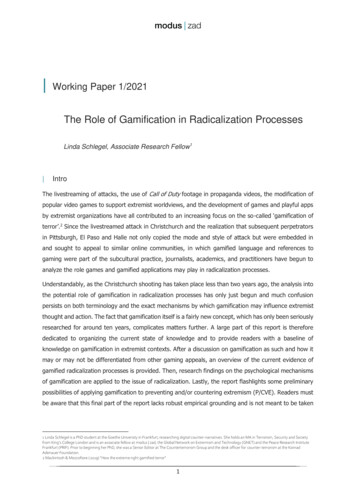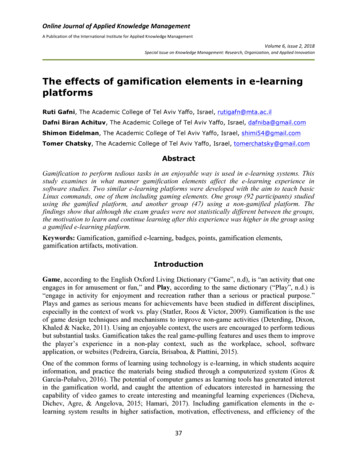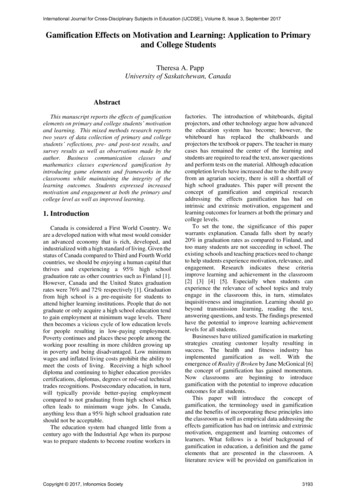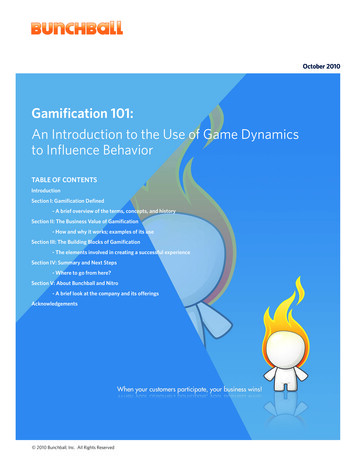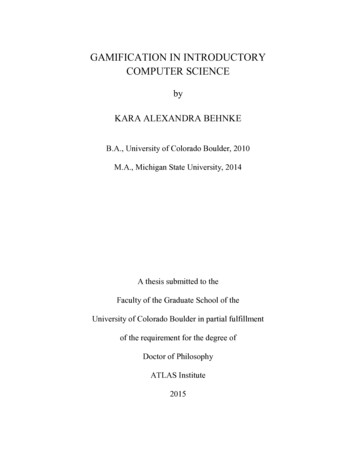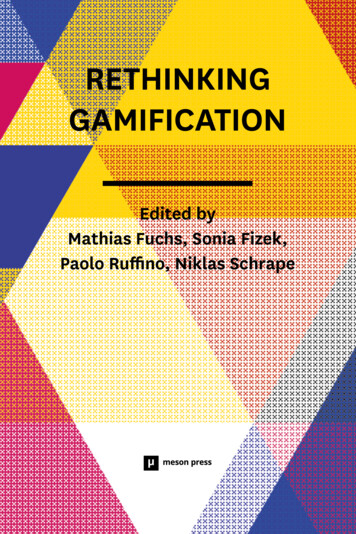
Transcription
RethinkingGamificationEdited byMathias Fuchs, Sonia Fizek,Paolo Ruffino, Niklas Schrape
RethinkingGamification
RethinkingGamificationEdited byMathias Fuchs, Sonia Fizek,Paolo Ruffino, Niklas Schrape
ImprintA collaboration between the Gamification Lab and the Hybrid Publishing Labat Leuphana University of Lüneburg, ublishing-lab/Editors Sonia Fizek, Mathias Fuchs, Paolo Ruffino, Niklas SchrapeEditorial Assistance and Project Management Fabian LehmannProofreading and Editorial Assistance Jacob WatsonLayout, Design, and Artwork Laleh Torabimeson press Mercedes Bunz, Marcus Burkhardt, Andreas KirchnerBibliographical Information of the German National LibraryThe German National Library lists this publication in the Deutsche Nationalbibliografie(German National Bibliography); detailed bibliographic information is available online athttp://dnb.d-nb.de.Published in 2014 by meson press, Hybrid Publishing Lab, Leuphana University of Lüneburg,Germany. www.meson-press.comThe paperback edition of this book is printed by Lightning Source, Milton Keynes,United Kingdom.The digital editions can be downloaded freely at www.meson-press.com.ISBN (Print): 978-3-95796-000-9ISBN (PDF): 978-3-95796-001-6ISBN (EPUB): 978-3-95796-002-3Funded by the EU major project Innovation Incubator LüneburgThis publication is licensed under the CC-BY-SA 4.0 (Creative Commons AttributionShareAlike 4.0 Unported) license.To view a copy of this license, visit: http://creativecommons.org/licenses/by-sa/4.0/.
ContentsIntroduction . 7Resetting BehaviourNiklas SchrapeGamification and Governmentality .Paolo RuffinoFrom Engagement to Life, or: How to Do Things with Gamification? .Maxwell FoxmanHow to Win Foursquare: Body and Space in a Gamified World .Joost RaessensThe Ludification of Culture .21477191Replaying HistoryMathias FuchsPredigital Precursors of Gamification . 119Felix RaczkowskiMaking Points the Point: Towards a History of Ideas of Gamification . 141Reframing ContextFabrizio PoltronieriCommunicology, Apparatus, and Post-History: Vilém Flusser’sConcepts Applied to Videogames and Gamification . 165Thibault PhilippetteGamification: Rethinking ‘Playing the Game’ with Jacques Henriot . 187Gabriele FerriTo Play Against: Describing Competition in Gamification . 201
Reclaiming OppositionDaphne DragonaCounter-Gamification: Emerging Tactics and Practices Against the Ruleof Numbers . 227Matthew TiessenGamed Agencies: Affectively Modulating our Screen and App-DrivenDigital Futures . 251Remodelling DesignSonia FizekWhy Fun Matters: In Search of Emergent Playful Experiences . 273Scott NicholsonExploring the Endgame of Gamification . 289Sebastian DeterdingEudaimonic Design, or: Six Invitations to Rethink Gamification . 305AppendixAuthors . 333Index . 337
IntroductionThis book is about gamification, and much more. The publication intendsto explore the concept of gamification, its history and applications, its implications for theory and practice. It also aims at doing more than simplymapping a trend, or providing guidelines for the design of gamificationapps. In this book the concept of gamification will be rethought, throughseveral distinct approaches and a multitude of questions.But first, what is gamification? Gamification can be approached in atleast two ways. First, as a general process in which games and playful experiences are understood as essential components of society and culture.From this perspective we could look at how practices and rituals, belonging to different historical and cultural contexts, might take the form of orresemble a game. Roger Caillois, while drawing on anthropology, biologyand the study of myths, has shown how the playful might in fact belong toliving beings of any kind, and not be limited to the human sphere. It mightalso be less of a process of rationalisation, and more of an instinctive reaction to the surrounding environment, a form of adaptation that connects lifeand death into one single thing (Caillois 1960, 1961 and 1964). Before him,Johan Huizinga had already argued that play is an essential component in7
the formation of societies and civilisation (1949 / 1938). From this perspective, gamification may be viewed as a much broader phenomenon, and as aconcept not nearly as novel as many would have us believe.More recently, however, gamification has also been used to describe amuch more limited practice. This second and more widely-known meaning has been brought forward by marketing gurus and designers over thelast few years. It is this latter sense that has led to a great number of definitions on gamification. It is also this second meaning that drives us to discussgamification in the context of this publication. Sebastian Deterding, RillaKhaled, Lennart Nacke and Dan Dixon have proposed a tentative history ofthe term: “ ‘gamification’ as a term originated in the digital media industry.The first documented use dates back to 2008, but gamification only enteredwidespread adoption in the second half of 2010” (Deterding et al. 2011, 1).In other publications we can read that extensive use of the term hasbeen reported from 2010, but its origins are probably to be found in a British consultancy company, Conundra Ltd., founded in 2003 by Nick Pelling,a game designer, who claimed to be specialising in gamification (Werbachand Hunter 2012). The no longer active Conundra Ltd. focused on helping “manufacturers evolve their electronic devices into entertainment platforms” (Conundra Ltd. 2014). Its core business focused on advising companies interested in attracting new customers on the implementation of gamefeatures into the companies’ products and services. This type of activity wascalled “gamification” on Conundra’s website (ibid.). More recently the ideaof “gamifying” a business seems to have re-emerged, not necessarily directlyas a result of Pelling’s first attempt but in a very similar vein.Over the last few years the marketing and consultancy sectors have beenpromoting gamification as a potential source of revenue. This period hasalso witnessed the emergence of several events and publications that havecontributed to defining gamification. Gabe Zichermann’s and CristopherCunningham’s book Gamification by Design: Implementing Game Mechanicsin Web and Mobile Apps (2011) is one of the most popular in the businesscontext, as is Zichermann’s website Gamification.co and the associated annual conference Gamification Summit held annually in San Francisco since2011. Jane McGonigal’s work, expounded in her contribution at the TEDTalk series in 2010, is also concerned with “selling” gamification to corporations. In her book Reality is Broken: Why Games Make Us Better and How8
They Can Change the World (2011) she mostly looks at her own work asa consultant for McDonald’s, the Olympic Games organising committees,and other companies for whom she organised marketing campaigns basedon alternate reality games. In McGonigal’s view, gamification is not only anew goldmine for designers and business people; it is also a tool that has thepower to change the world.In her understanding, gamification is a concept that describes a newage where gamers can collectively use their problem-solving skills not onlyto solve puzzles within a digital game but also to approach social and political issues in the real world. Gaming, according to McGonigal’s vision,could and should play a redeeming role. Game designers could become thenew social entrepreneurs, and citizens become gamers. From this perspective, gamification thus becomes a technique for enabling greatly ambitiouschange. Reporter Alex Konrad on the Fortune segment of CNN Money described gamification as a sort of new “Wild West” on the 17th of October2011: “gamification is the hot new business concept, with many of the world’smost admired companies signing on” (Konrad 2011).1 On the 10th of October Rachel Emma Silverman of the Wall Street Journal also declared thatcompanies all over the world were already jumping onto the gamificationbandwagon (Silverman 2011).It seems that gamification is now the keyword for a generation of social entrepreneurs and marketing experts, in perfect and timely combination with the re-evaluation of participatory practices (as also recorded inthe art and cultural sector, see Bishop 2012) and the trends of quantificationand self-governance (often categorised under the label of the Quantified Selfmovement). Thus, the question remains: Does gamification need to be rethought? Is there something wrong with it? Or to put it differently, why dowe need this book in the first place?Let us start by saying that, according to its many promoters and “evangelists”, there is nothing wrong with gamification at all. Quite on the contrary, although the keyword might now be a bit more rusty than a few yearsago, consultancies and workshops on this topic are still popular, as well asacademic courses and training programmes. In the blogs, workshops, and1Konrad’s emphasis.9
publications on the topic it seems that gamification is working so well thatthe last thing it needs is second guessing. Consumer loyalty, issues related tofinance and governance, workers’ productivity, training and development –these are only some of the areas that are allegedly being positively revolutionised by the emergence of gamification.However, if we have to summarise why gamification needs to be rethought in a sentence, it would be: Precisely because it “works”. The numberof statements produced in support of the rise of gamification and the wideadoption of this concept, in both private and public sectors, force us, thinkers and players, to consider what exactly is at stake in its emergence. Whatcould it possibly be that makes such an enthusiastic narrative apparentlyfulfil itself so perfectly? How come the ideas surrounding gamification happened to confirm themselves with no need for further discussion?The number of critiques of gamification is in fact already quite large.As outlined by Ian Bogost in several contexts (2011a, 2011b), gamificationhas little to do with the design of games (or an allegedly salvific process),and much more with the exploitation of consumers. It frustrates the practice of game design and reduces playing to a stimulus-response experience;whereas, games, and video games in particular, have been trying to differentiate and complicate the meanings of play in a digital culture. Gamificationso far has been a bad word for those involved in the study and understandingof video games, as it has been associated with a process of appropriation ofthe values of digital gaming by marketing and business interests. It seemsthat gamification “works” only in the eyes of those who have been inventingand promoting it in the first place. In other words, gamification needs toeither disappear or be rethought, if it wants to gain the respect of those whohave been working with games over the last decades.This book proposes to keep the word, but change its meanings and theideas associated with it. While gamification might work just fine as it is nowfor those who have been evangelising about its redeeming properties, it isalso too limiting a concept for conveying political statements, artistic values,educational content or any sort of unconventional message through games.The first section of this book is a collection of articles that try to grasphow gamification appears to be rooted in a specific understanding of theconcept of behaviour, as something to be affected through the design of agame-like environment. Behaviour has been extensively discussed in nu-10
merous texts on gamification. Niklas Schrape proposes looking, throughFoucault, at how gamification might work as a method to regulate individuals and their social lives. It also works as a pleasant regulator of behaviourbecause it offers positive feedback (rewards, leaderboards, etc.) rather thannegative penalties (fines, prison, etc.). Schrape first looks at how airline frequent-flyer programmes operate. Extrapolating this example, he sketches alibertarian and dystopian society that would result from the domesticationof human beings via governance mechanisms modelled on customer loyaltyprogrammes, putting the very concept of democracy in crisis. In such a scenario, the very concept of free will can be disputed and questioned.Paolo Ruffino looks instead at engagement, another keyword in thestudies on gamification, and proposes to rethink the models underpinningthe discourses on gamification and its capacity to affect the behaviour ofplayers. Ruffino looks at the work of Tim Ingold and his reading of Bergsonand Heidegger and argues that participation, dwelling and co-existencecould be seen as alternative ways of thinking about engagement: less as atransitive process that goes from games to their players and more as an intransitive status that needs to be narrated in order to be of any value. He thenproposes recuperating, from the theoretical perspective he offers, the notionof life itself, a topic rarely debated in relation to gamification, which couldinstead help us in the invention of a creative way of approaching games bothin our playing and research practices. Ruffino explores the implications ofswitching the focus from the idea that games “affect us” on the possibilitiesoffered by thinking of games as things we live with and within. He concludesby showing how some artistic projects could be seen as examples of differentways of being engaged with both video games and gamification.Life and movement are also relevant in the following contribution byMaxwell Foxman, who provides a deep look at one of the most notoriousgamified applications, Foursquare. The author’s main concern is to explorewhat it is that drives players to engage with an app like Foursquare, andhow it affects the ways in which movement and body presence are understood. He argues that Foursquare alters the experience of moving about onthe streets of a city and establishes a form of communication based on bodilyproximity. It is a form of expenditure, as Bataille would put it, which preserves competition and rivalry, but now entirely based on movement.11
Joost Raessens examines how gamification could be seen in the contextof a more general “ludic turn”, which affects society and culture at manydifferent levels. This century, Raessens notes, has seen several differentkinds of “turns”: We have seen the linguistic turn, the digital, followed bythe material one and many others. To what extent could we say that we arenow experiencing a playful turn – in the sense of a cultural shift that bringsplayful experiences to the centre of the use, design, and study of media andtechnologies? Raessens argues that this perspective could in fact be usefulin understanding contemporary Western culture, drawing on several examples from a variety of contexts. Gamification could then be understood asanother example of this more general process. The ludification of culture,as Raessens puts it, thus becomes a strategic concept for understanding andmaking sense of current changes in contemporary culture.The second part of the book looks at the history of games as a potential source for formulating different definitions of gamification. Similarlyto Raessens, Mathias Fuchs intends to put gamification into a cultural-historical context. Fuchs offers a retrospective on the use of games in variousspheres of social life, including religion and economy. The ways in whichgames permeate these aspects of culture is not, according to Fuchs, a prerogative of the digital era. It is in fact an ongoing and continuous influence,which also generates similar forms of hysteria towards the ludicisation ofsociety in different ages. Gamification becomes, through the historical overview offered by Fuchs, the name of a relatively recent development in a muchlonger process, whose origins are difficult to trace, but which nonethelesspresents interesting similarities with the hopes and concerns raised today inthe discourses surrounding gamification.Points and rankings, another oft-debated part of gamification, are thesubject of Felix Raczkowski’s contribution. The author perceives this aspectas a legacy of behaviourism and psychiatry as these disciplines developedduring the 1960s. He then argues that a critique of gamification has to dealwith this theoretical heritage, which is not always made explicit but indeednevertheless informs a great many of the current discourses on the topic.The author proposes, for instance, that the enthusiastic views on the effectsof gamification and gamified apps might in fact be consistent with this background. The complex position of the player, who is mostly expected to follow precise guidelines in order to win the game, also raises issues about the12
value of these kinds of playful practices since they appear to be capable ofaltering the user’s behaviour. Raczkowski also suggests that gamification canand should be critiqued from an historical perspective, looking at the intricacies of its origins and the ideas that have made it possible, at one point inhistory, to institutionalise the practice of making games with the purpose ofaffecting players’ behaviours.The third section of the book looks at gamification in relation to thecontexts of making and playing. This area is approached in different ways bythe authors. Fabrizio Poltronieri brings to video games and gamification theconcepts of communicology, apparatus, technical images, and post-history,as initially proposed by Vilém Flusser. An historical overview is presentedfrom Flusser’s perspective in order to argue that gamification might represent a phase in a post-historical era, one where the projection of realities onthe natural world plays a dominant role. Poltronieri’s proposal shows thepotential for studying digital games in general by applying Flusser’s theories,which he brilliantly presents and introduces to the readers in all their complexity. In this paper the context in which games are played and understoodmoves radically from the usual understanding of both video games andgamification, opening up many potential consequences for game studies.Gabriele Ferri looks instead at competition and antagonism in gamification, at how these are usually presented in the apps and systems that relyon gamification techniques and how they have been understood thus far.Ferri proposes a semiotic perspective on the issue of competition, re-evaluating concepts such as the actant and the semiotic square. He also proposesdistinguishing between what he calls “interstitial” and “exclusive” gamification; the former being an activity that is carried out simultaneously toother activities, and the latter being instead a text that completely absorbsthe player. From this theoretical background, Ferri establishes some crucialdistinctions in the varied field of gamification and explores how competition could become a key element in understanding the different values andmeanings at stake while rethinking gamification.Thibault Philippette offers a reading of gamification based on the workof Jacques Henriot and his sciences du jeu or “play studies”, whose work,according to Philippette, could be used to reconsider some of the basic concepts of gamification as proposed by designers and gurus of the concept.The main problem Philippette is concerned with is the arbitrary distinction13
between games and non-games, a distinction implied in the definition ofgamification as the use of game elements in a non-game context. While thisdistinction is arbitrary, it also reveals a rather static view of games, whichcould instead become more interesting if opened up to other kinds ofdefinitions. Philippette suggests the very idea that games that can influencethe non-game context could be re-interpreted following Henriot’s theorieson play.Daphne Dragona introduces the fourth section of the book, which isfocused on forms of antagonism and opposition to gamification. Dragonaillustrates what she defines as “counter-gamification”. Counter-gamificationis not a precise practice; it is not defined in guidebooks, workshops, or tutorials. It is instead a form of appropriation of playful elements by artistsin order to promote radical and oppositional values. Dragona commentson several projects, less known than the marketed apps that strongly relyon gamification techniques, but still based on a game-like environment.Dragona’s ambition is to map the territory outside the most well-knownforms of gamification and expand it by including alternative practices of political disobedience that come to be organised as games. Dragona expressesthe need to oppose the current trends of gamification and to expand whatcould potentially be defined as an alternative use of games. Dragona’s mainfocus is on the effects of gamification on social networking sites and on theprocess of “datafication”, which generates forms of resistance from users andartists.Matthew Tiessen expands Dragona’s perspective by asking to whatextent gamification can be viewed as desirable by players and societyin general. To what extent are gamification apps to be “played” ratherthan accomplished and fulfilled to receive pre-established rewards? Howmuch enjoyment is expected from playing with gamified apps? If gamification is mostly about directing players’ behaviour then it also results,Tiessen suggests, in the objectification of human agency and in the elimination of choice in the practices of playing. Gamification risks leaving playersin a passive condition rather than giving them an active role in choosinghow to change themselves and the worlds surrounding them.The final part of the book explores issues related to design, with threeimportant contributions that offer original ways of thinking about how touse gamification. The authors have in fact explored those techniques and14
reinvented them in order to forge a new approach to the creation of playfulenvironments. None of them offer a proper step-by-step guide, as might beexpected in a typical gamification textbook. Instead, they discuss their experience and practice as a way of reimagining the use of games in a non-gamecontext, and as a theoretical contribution to the debates on gamification.Sonia Fizek looks at how gamification might look like in the “post-bullshit” era, when the focus on points, leaderboards and more generally on theone-size-fits-all approach will be over. Fizek argues that emergent playfulness, a concept she elaborates by drawing on the work of Eric Zimmermanmostly, might be a more interesting concept to look at, rather than the design techniques proposed so far by gamification experts. However, it is also amuch more complex concept, difficult to grasp and yet more capable of capturing the interest of the players. Gamification gurus themselves, Fizek saysand as has emerged in some of the most recent conferences on this topic, arenot completely satisfied with the practice they are supporting and contributing to establish. There is a shared feeling that gamification, as it is now, mightbe missing the point, and be successful only in very precise and much morelimited circumstances than what originally had been proclaimed possible.Fizek’s proposal is to expand the concept of play and fun and to introducenew forms of engagement in the practice of gamification.Scott Nicholson turns to the relation between “grinding”, a conceptmostly used in massively multiplayer online role-playing games, and gamification. Grinding consists of accumulating points and improving the player’sstatistics. Nicholson argues that many gamification apps and systems tend tore-purpose a similar approach in a different context. However, these specifictypes of role-playing games also have an “endgame” component, where players, once all has been achieved that could be possibly accomplished, continue to exploit the game’s open-worldness, caring less for game tasks andfocusing more on non-progression-motivated play. If the endgame approachwere applied to gamification, Nicholson argues, we could see very differentways of designing and playing. The author explores these alternative modesof gamifying things through a text that offers both a theoretical understanding of gamification and exceptionally useful suggestions for designers.Last but not least, Sebastian Deterding closes the publication witha re-interpretation of his original definition of gamification as the “use ofgame design elements in non-game contexts”, as formulated with colleagues15
Dixon, Khaled, and Nacke in 2011. Here he presents six critiques of the current dominant models for the understanding of gamification, starting fromthe deterministic models of game design that he considers to be replicatedin this new context. Deterding proposes an optimistic view of gamification,that still preserves its transformative and critical values but from a morecomplex, relational, and emergent perspective. He names this new form ofdesign “eudaimonic”, an autotelic practice which is equivalent, in Aristotle’soriginal view, to the “good life”. The instrumental element that gamification all too often brings to games and work risks perpetuating a “bad life”instead, one where self-discovery and pleasure rarely happen. Instead, aneudaimonic view of gamification could bring a “good” way of living andplaying, one where joy and satisfaction are at the centre of a responsiblepractice. Gamification, according to Deterding, could become the name of aplay practice that truly helps human beings in fulfilling their own lives andthose of others, but it needs to change in order to do this – it needs to be “rethought”. His text can be read as a final and conclusive manifesto for anyonewho is involved in gamification, from a theoretical or practical standpoint.In conclusion, we hope this publication will revamp the debate ongamification as a much more general concept for the study and adoption ofgames, or game-like environments, and their influences in contemporarylife. This is also the ambition and goal of our research centre, the Gamification Lab, where we have just started to investigate the many implicationsof game technologies, and their ethical, political, artistic, and educationalvalues. We believe that gamification has the potential to become a commonterm for thinking about and doing games – both practices seen as dependent on and in communication with one another. We hope this book willraise questions on this subject and contribute to further innovative researchdirections for gamification.16
BibliographyBishop, Claire. 2012. Artificial Hells: Participatory Art and the Politics of Spectatorship.London: Verso Books.Bogost, Ian. 2011a. “Persuasive Games: Exploitationware.” Gamasutra, May asive games exploitationware.php.Bogost, Ian. 2011b. “Gamification Is Bullshit! My Position Statement at the WhartonGamification Symposium.“ Ian Bogost Blog, August 8.http://www.bogost.com/blog/gamification is bullshit.shtml.Caillois, Roger. 1964. The Mask of Medusa. New York: C.N. Potter.Caillois, Roger. 1961. Man, Play and Games. New York: Free Press of Glencoe.Caillois, Roger. 1960. Man and the Sacred. New York: Free Press of Glencoe.Conundra Ltd. 2014. “Conundra.” Accessed April ng, Sebastian, Dan Dixon, Rilla Khaled and Lennart Nacke. 2011. “FromGame Design Elements to Gamefulness: Defining Gamification.” In Proceedings of the 15thInternational Academic MindTrek Conference: Envisioning Future Media Environments,9–15. New York: ACM.Escribano, Flavio. 2012. “Gamification as the Post-Mortem Phalanstere: Is the GamificationPlaying with Us or Are We Playing with Gamification?” In The Video Game Industry:Formation, Present State, and Future, edited by Peter Zackariasson and Timothy L. Wilson,198–219. New York and London: Routledge.Huizinga, Johan. 1949 / 1938. Homo Ludens: A Study of the Play-Element in Culture. London:Routledge and Kegan Paul.Konrad, Alex. 2011. “Inside the Gamification Gold Rush.” CNN Money, October 17. AccessedApril 26, cation/.McGonigal, Jane. 2011. Reality is Broken: Why Games Make Us Better and How They CanChange the World. New York: Penguin Press.Silverman, Rachel Emma. 2011. “Latest Game Theory: Mixing Work and Play.” The WallStreet Journal, October 10. Accessed April 26, 4052970204294504576615371783795248.Werbach, Kevin and Dan Hunter. 2012. For the Win: How Game Thinking Can Revolutionize your Business. Philadelphia: Wharton Digital Press.Zichermann, Gabe and Cristopher Cunningham. 2011. Gamification by Design: Implementing Game Mechanics in Web and Mobile Apps. New York: O’Reilly Media.17
18
ResettingBehaviour19
GamificationAnd Governmentalityby Niklas SchrapeIntroductionThis article suggests a research perspective that investigates the techniques
tive, gamification thus becomes a technique for enabling greatly ambitious change. Reporter Alex Konrad on the Fortune segment of CNN Money de-scribed gamification as a sort of new “Wild West” on the 17th of October 2011: “gamification
